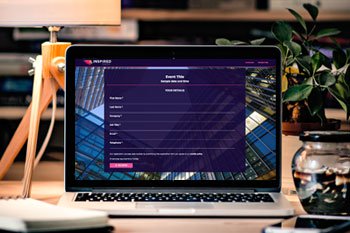When it comes to webinars, it’s easy to get bogged down in the details. Should you sit or stand? Should your event look like a conference call or a polished TED Talk? These questions are especially daunting when you’re running your very first webinar. In Episode Four of Webinars Unfiltered, the WorkCast team dove into this debate to help a first time webinar creator navigate the tricky balance between style, substance, and practicality.
Here’s what we uncovered.
The Debate: Sitting vs Standing, Conference Call vs TED Talk
The dilemma:
“Should webinar presenters be sitting down at a desk like a conference call or presenting standing up like a lecture or TED talk?
We’re having our first webinar this year as a company and there’s a split on the exec team regarding how it should be presented. Some people say a webinar is almost always done like a conference call while others say it needs to look like an interactive TED talk with a whiteboard or green screen and the presenters are standing up when talking.
We don’t have a space to present on a whiteboard or a green screen. My thinking on this is that it’s our first webinar and we shouldn’t overcomplicate production with lapel mics and green screens. Also, most webinars look like conference calls. Also, it’d be weird to attend a webinar where the host is standing up in front of a classroom especially if that room is pretty much empty.
Our VP insists we “do it right the first time” and make it look like a TED talk as if that will boost our legitimacy. Keep in mind our attendance on this will be small."
The question resonated with our hosts, Natalie Parsons, Rachel Charlton, and Chris Hopper. Having experienced everything from stripped-back, single-camera setups to multi-camera productions with high-end visuals, they had plenty of insights to share.
Keep It Simple for Your First Webinar
“Your first webinar is about building confidence and nailing the basics,” Natalie explained. A simple setup—just you, your camera, and your message—helps presenters focus on the content rather than worrying about production value.
Chris added, “Don’t overcomplicate things. It’s better to deliver great content in a straightforward way than to risk technical issues with an overly complex production.”
A straightforward webinar format allows your team to:
-
Get comfortable presenting on camera.
-
Build familiarity with the platform.
-
Fine-tune your content delivery.
The TED Talk Temptation
Rachel acknowledged the allure of a TED Talk-style production. “A high-end setup can make your brand look polished and professional. But it comes with significant time, budget, and resource requirements—and you need to be confident in your ability to pull it off without a hitch.”
For businesses with limited experience or a small audience, a simpler approach is usually more practical. Rachel suggested testing the waters: “Start with a straightforward webinar and experiment with more complex formats later. Let audience feedback guide your decisions.”
Should You Sit or Stand?
The verdict? It depends on the tone and purpose of your webinar.
-
Sit if your webinar is conversational or information-heavy, like a panel discussion or a conference call.
-
Stand if you’re delivering a high-energy, motivational talk or presenting to a large, dynamic audience.
“At the end of the day, it’s all about comfort and content,” Chris said. “If you’re more confident sitting, then sit. Your audience cares more about what you’re saying than whether you’re sitting or standing.”
Tips for First Time Webinar Hosts
Whether you’re sitting or standing, here are some top tips from the team:
-
Rehearse: Practice your presentation and check your tech setup to avoid surprises on the day. Here are our Top 10 Tips for Presenting Webinars to get you started.
-
Define Your Goals: Understand what you want to achieve with the webinar—lead generation, education, or audience engagement.
-
Focus on Value: Prioritise delivering content your audience finds useful and engaging. Consider evergreen webinars to help provide on-going value. This is something that can be acchieved using on-demand and simulive webinars.
-
Research Formats: Look at other webinars and learn what works (and what doesn’t).
Final Thoughts
Running your first webinar can feel overwhelming, but the key is to start simple and scale up as you gain experience. As Natalie put it, “Your first webinar is a learning experience. Focus on delivering great content and don’t stress about production perfection.”
Still unsure? Whether you’re planning a straightforward webinar or dreaming of a TED Talk production, WorkCast’s team is here to help. Reach out for expert advice and support—we’ve got your back every step of the way.
Stay tuned for more episodes of Webinars Unfiltered as we tackle your biggest webinar challenges head-on.
Share this
You May Also Like
These Related Stories

10 Things You May Not Have Known About Webinars

What Equipment You Need for a Webinar: Our List



